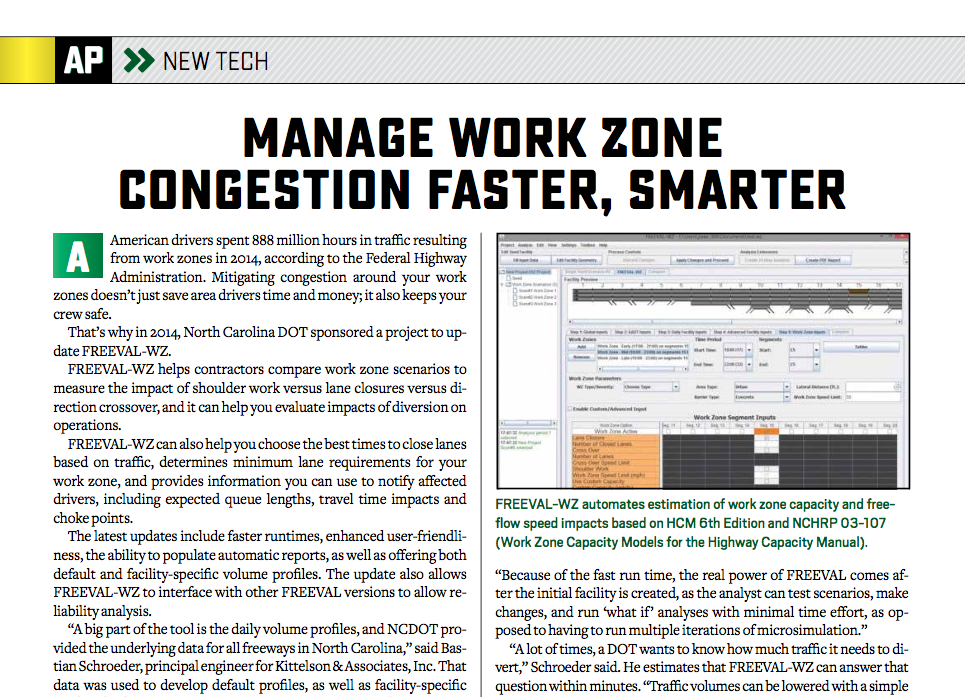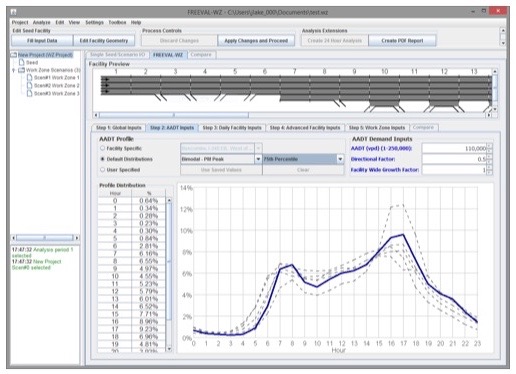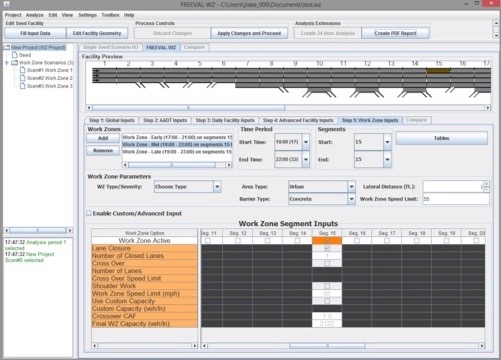Manage Work Zone Congestion with FREEVAL-WZ
BY AsphaltPro Staff

American drivers spent 888 million hours in traffic resulting from work zones in 2014, according to the Federal Highway Administration. Mitigating congestion around your work zones doesn’t just save area drivers time and money; it also keeps your crew safe.
That’s why in 2014, North Carolina DOT sponsored a project to update FREEVAL-WZ.
FREEVAL-WZ helps contractors compare work zone scenarios to measure the impact of shoulder work versus lane closures versus direction crossover, and it can help you evaluate impacts of diversion on operations.
FREEVAL-WZ can also help you choose the best times to close lanes based on traffic, determines minimum lane requirements for your work zone, and provides information you can use to notify affected drivers, including expected queue lengths, travel time impacts and choke points.
The latest updates include faster runtimes, enhanced user-friendliness, the ability to populate automatic reports, as well as offering both default and facility-specific volume profiles. The update also allows FREEVAL-WZ to interface with other FREEVAL versions to allow reliability analysis.
“A big part of the tool is the daily volume profiles, and NCDOT provided the underlying data for all freeways in North Carolina,” said Bastian Schroeder, principal engineer for Kittelson & Associates, Inc. That data was used to develop default profiles, as well as facility-specific profiles for freeways in North Carolina, and NCDOT staff also assisted with beta-testing the software.

FREEVAL-WZ integrates default hourly volume profiles (rural, urban-AM, urban-PM), facility-specific profiles (for North Carolina), and the ability to enter user-defined volume profiles from local data.
FREEVAL-WZ In Action
While working with NCDOT, Schroeder’s team ran different diversion scenarios and work zone configurations to ensure smooth traffic flow through a work zone on I-40 in North Carolina. They discovered that with two lanes open, they would need to divert 50 percent of traffic to keep average travel speeds at about 20 miles per hour through the work zone, but if they could leave three lanes open, diverting 20 percent of traffic would allow a 40 mile-per-hour travel speed.
“These two simple numbers were key to convince NCDOT senior management that the two-lane option was unrealistic,” Schroeder said. Not only was a 50 percent diversion for a busy freeway unrealistic, but it would also result in undue burden to surrounding surface streets. “Through our analysis, NCDOT had a clear target and a clear message to communicate to the public about the importance of seeking out alternate modes of travel.”
FREEVAL-WZ also requires fewer inputs and returns results faster than microsimulation, according to Schroeder. For example, key calibration parameters, like bottleneck capacity, are an explicit input, meaning they don’t need to be measured via simulation.
“The run-time of FREEVAL is essentially instantaneous, making it much faster to error-check and calibrate the model,” Schroeder said. “Because of the fast run time, the real power of FREEVAL comes after the initial facility is created, as the analyst can test scenarios, make changes, and run ‘what if’ analyses with minimal time effort, as opposed to having to run multiple iterations of microsimulation.”
“A lot of times, a DOT wants to know how much traffic it needs to divert,” Schroeder said. He estimates that FREEVAL-WZ can answer that question within minutes. “Traffic volumes can be lowered with a simple reduction factor, and the analysis re-run in a matter of seconds.”

FREEVAL-WZ automates estimation of work zone capacity and free-flow speed impacts based on HCM 6th Edition and NCHRP 03-107 (Work Zone Capacity Models for the Highway Capacity Manual).
How FREEVAL-WZ Works
To use FREEVAL-WZ, you must first enter basic information, like facility parameters, duration of project, number of segments, and other data. Next, you’ll need to input average annual daily traffic (AADT), as well as related information, like distribution shape, direction factor and growth factor.
After inputting AADT data, you’ll need to add daily facility inputs, like the geometry of the facility, including number of lanes, length, type and ramp location, as well as daily traffic demand on ramps. Contractors can also further customize their results by providing more information, including Highway Capacity Manual inputs.
Then you’ll put in work zone inputs, like location, time and type, and FREEVAL-WZ will provide a comparison, summary and detailed analysis of work zone scenarios.
FREEVAL-WZ is one resource in the FREEVAL suite of free open-source tools to evaluate freeway operations. It was developed in the 1990s, and has continuously been improved since its creation. It is the official computational engine of the Transportation Research Board’s Highway Capacity and Quality of Service Committee for freeways.
To watch tutorial videos about FREEVAL-WZ, visit go.ncsu.edu/freeval.
